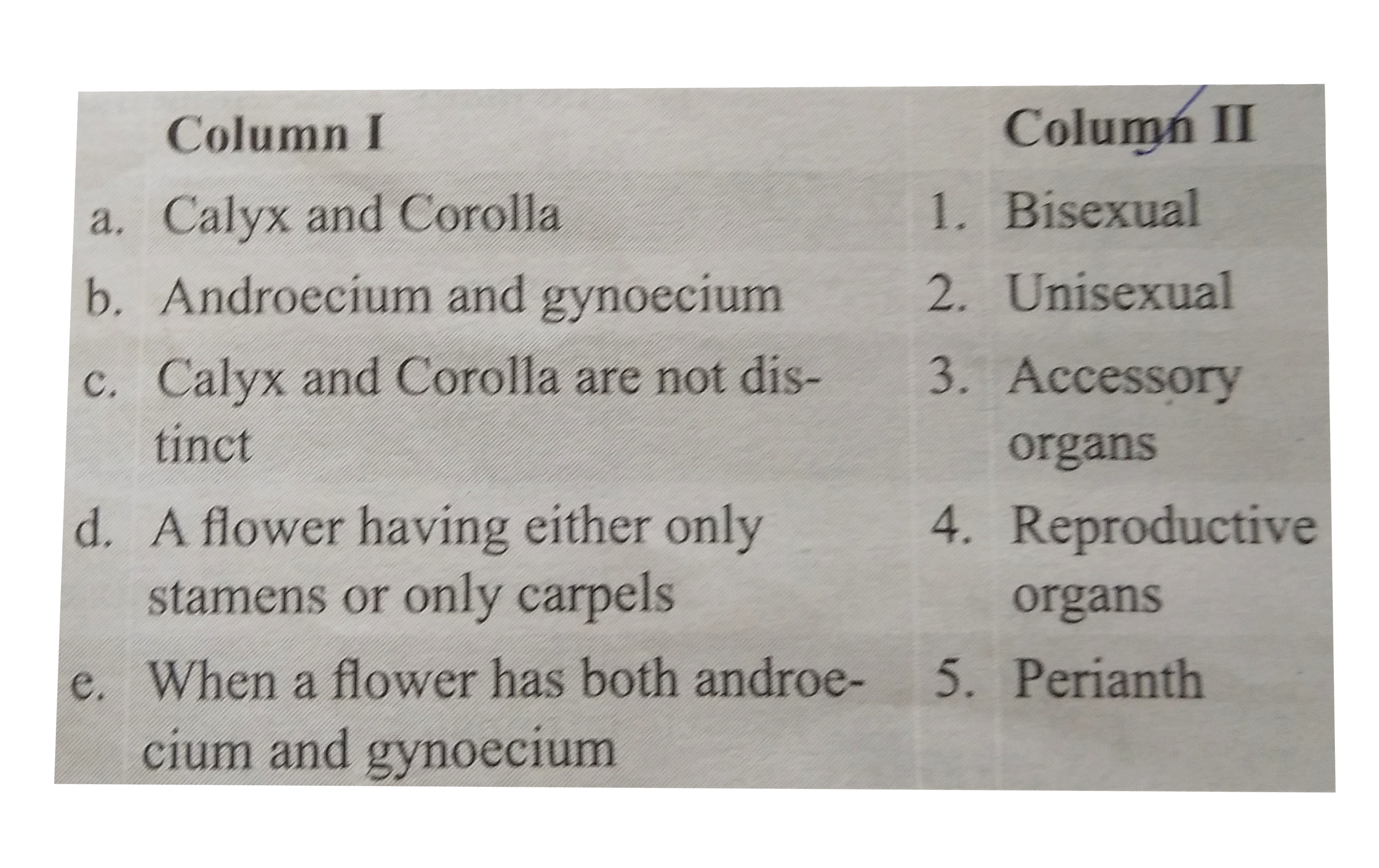Match the following and choose the correct combination from the options given.
A - 4 , B - 3, C - 2 , D - 1
A - 1, B - 2, C - 3 , D - 4
A - 2 , B - 3, C - 4 , D - 1
A - 3 , B - 4, C - 1 , D - 2
The correct Answer is:D
To solve the matching question, we need to correlate the plants listed in Column I with the correct morphological characteristics described in Column II. Here's a step-by-step breakdown of the solution:
Step 1: Analyze Column I
- A. Mustard
- B. Brinjal
- C. Citrus
- D. Pea
Step 2: Analyze Column II
- 1. Polyadelphous
- 2. Diadelphous
- 3. Variations in the length of filaments
- 4. Epipetalous stamens
Step 3: Match Each Plant with Its Characteristic
1. Mustard (A):
- Mustard flowers exhibit variations in the length of filaments.
- Match: A - 3 (Variations in the length of filaments)
2. Brinjal (B):
- Brinjal belongs to the Solanaceae family, where stamens are often fused with the petals, a condition known as epipetalous stamens.
- Match: B - 4 (Epipetalous stamens)
3. Citrus (C):
- Citrus flowers typically show a polyadelphous condition, where multiple stamens are fused into groups.
- Match: C - 1 (Polyadelphous)
4. Pea (D):
- Pea flowers exhibit a diadelphous condition, where the stamens are arranged in two bundles.
- Match: D - 2 (Diadelphous)
Step 4: Final Matching
Now that we have matched each plant with its respective characteristic, we can summarize the final combinations:
- A - 3 (Mustard - Variations in the length of filaments)
- B - 4 (Brinjal - Epipetalous stamens)
- C - 1 (Citrus - Polyadelphous)
- D - 2 (Pea - Diadelphous)
Final Answer
The correct combination is:
- A - 3
- B - 4
- C - 1
- D - 2
- A. Mustard
- B. Brinjal
- C. Citrus
- D. Pea
- 1. Polyadelphous
- 2. Diadelphous
- 3. Variations in the length of filaments
- 4. Epipetalous stamens
1. Mustard (A):
- Mustard flowers exhibit variations in the length of filaments.
- Match: A - 3 (Variations in the length of filaments)
- Brinjal belongs to the Solanaceae family, where stamens are often fused with the petals, a condition known as epipetalous stamens.
- Match: B - 4 (Epipetalous stamens)
- Citrus flowers typically show a polyadelphous condition, where multiple stamens are fused into groups.
- Match: C - 1 (Polyadelphous)
- Pea flowers exhibit a diadelphous condition, where the stamens are arranged in two bundles.
- Match: D - 2 (Diadelphous)
Now that we have matched each plant with its respective characteristic, we can summarize the final combinations:
- A - 3 (Mustard - Variations in the length of filaments)
- B - 4 (Brinjal - Epipetalous stamens)
- C - 1 (Citrus - Polyadelphous)
- D - 2 (Pea - Diadelphous)
The correct combination is:
- A - 3
- B - 4
- C - 1
- D - 2
Topper's Solved these Questions
Similar Questions
Knowledge Check
Match the Column I and II, choose the correct combination from the option given.
 Aa-3, and 5,b-1, 2 and 6Ba-1,2, and 5,b-3, 4 and 6Ca-3,4, and 6,b-1, 2and 5Da-1,2 and 6,b-3,4 4 and 5
Aa-3, and 5,b-1, 2 and 6Ba-1,2, and 5,b-3, 4 and 6Ca-3,4, and 6,b-1, 2and 5Da-1,2 and 6,b-3,4 4 and 5Match the columns I and II choose the correct combination from the options given
 Aa-4,b-3,c-2,d-1,e-5Ba-3,b-4,c-5,d-1,e-2Ca-3,b-4,c-5,d-2,e-1Da-4,b-3,c-2,d-2,e-1
Aa-4,b-3,c-2,d-1,e-5Ba-3,b-4,c-5,d-1,e-2Ca-3,b-4,c-5,d-2,e-1Da-4,b-3,c-2,d-2,e-1Match the columns I and II choose the correct combination from the options given
 Aa-2,b-4,c-1,d-5,e-3Ba-5,b-3,c-2,d-4,e-1Ca-1,b-5,c-2,d-3,e-4Da-5,b-3,c-2,d-1,e-4
Aa-2,b-4,c-1,d-5,e-3Ba-5,b-3,c-2,d-4,e-1Ca-1,b-5,c-2,d-3,e-4Da-5,b-3,c-2,d-1,e-4
Match the columns I and II choose the correct combination from the options given

View SolutionMatch the columns I and II choose the correct combination from the options given

View Solution
Match the column I and II and choose the correct combination from the options given.
View Solution
Match the column I and II, and choose the correct combination from the option given.
View Solution
Match the column I and II, and choose the correct combination from the options given.
View Solution


